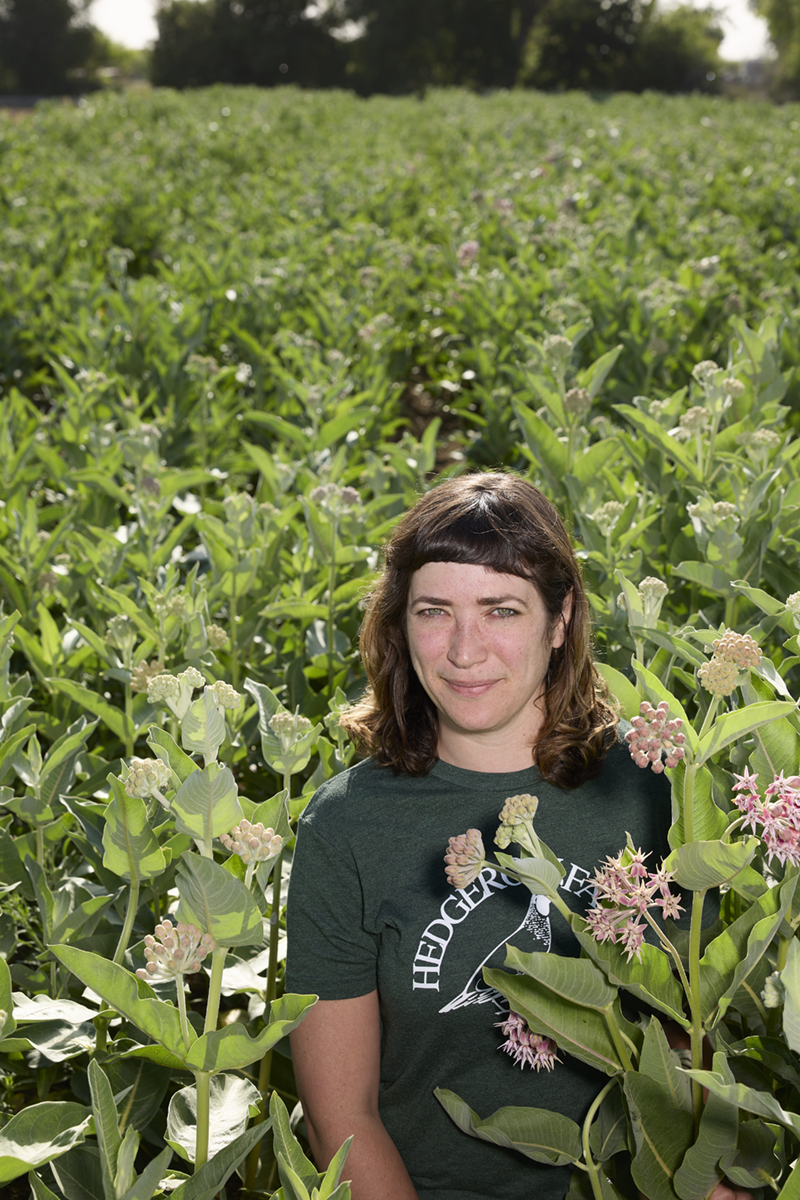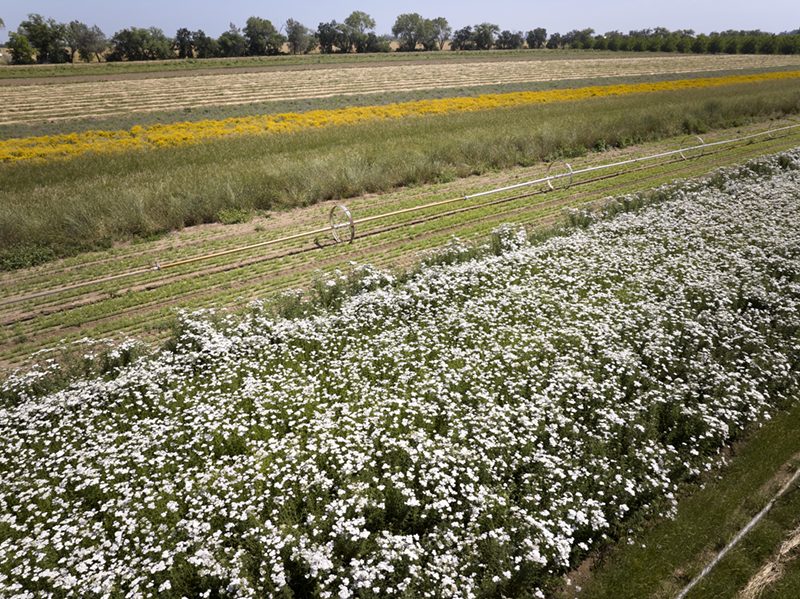Yolo County farm cultivates seeds, ecological restoration

Photo/Fred Greaves

Photo/Fred Greaves
By Caleb Hampton
In Yolo County, nestled among sprawling orchards and field crops, is a one-of-a-kind farm.
Each spring and summer, Hedgerow Farms turns into a patchwork of yellows, greens and violets as its fields of native wildflowers come into bloom. For more than three decades, the farm has cultivated native plants for seed production, supplying land managers working to restore wildlife preserves and other nature areas.
“We basically create our own superbloom,” said Julia Michaels, restoration ecologist at Hedgerow Farms. “We go out into the wild and, with permission, find big blooms of native wildflowers and collect a small amount of the seed.” Hedgerow Farms uses the wild seed to plant a field of the native species at its 300-acre farm near Winters, “turning a handful of wild-collected seed into thousands of pounds of seed.”
The farm was founded in the 1980s by John Anderson, a veterinarian, environmentalist and farmer credited with pioneering sustainable agriculture methods such as hedgerows, rows of native trees and shrubs planted between fields.
“He just started planting natives because he saw a need for it, learning along the way, and it became so valuable for the restoration community,” Michaels said. Anderson died in 2020 at the age of 77.
Hedgerow Farms produces around 400 species of native grasses and wildflowers, which it sells to government agencies and other land managers for use in ecological restoration projects, often after wildfires, floods or other disasters. “What we’re doing is amplifying the amount of seed that eventually goes back into the wild,” Michaels said.
She likens the farm to captive breeding programs that help endangered animal species reproduce in captivity before releasing them back into nature.
The farm harvests plants for seed from April through October, using machines similar to wheat or rice harvesters. The plants are then dried on tarps and put through combines to separate the seeds from the plant material. The seeds are cleaned and shipped to a warehouse in San Joaquin County.
Native plants grown at the farm include blue-eyed grass, poppies, lupine, sage and many others. Over the years, the farm has built an inventory of millions of pounds of native seeds. Hedgerow also has a farm in Santa Barbara County, where it grows plants better suited to coastal climates and soil types.
Because the farm is so unique in what it grows, “there’s lots of trial and error and learning from mistakes and experiences,” said farm manager Jeff Quiter. “There’s not a lot of research on stuff that we grow.”
A handful of farms have adopted Hedgerow’s model. But for years, according to land managers, Hedgerow Farms was on its own in producing native plant seed in California, and it continues to lead the way.
“They were out there alone forging the way for restoration,” said Stacy Martinelli, environmental scientist for the California Department of Fish and Wildlife.
The department, which must go through a bidding process before making purchases, had to write special contracts with Hedgerow Farms because “they were the only company that provided what we wanted,” Martinelli said.
One of the keys to the farm’s success, Michaels said, is the knowledge and experience of its collections experts. Originally from Chiapas, Mexico, Manolo Sánchez was working in Sutter County’s apple, peach and prune orchards in 2010, harvesting fruit and doing other traditional farm work, when his friend, Alejandro García, invited him to work at Hedgerow Farms.
Since then, Sánchez and García have crisscrossed California, going as far north as Humboldt and as far south as Bakersfield, trekking through hills and creek beds to collect samples of native grasses and wildflowers to plant at Hedgerow Farms. “They’re some of the best botanists in the state,” Michaels said.
The farm pays close attention to the genetics of each species, which is tied to a particular location, microclimate and soil type. “Every species we grow has a place it was originally collected from. We generally try to return the species back to that area,” Michaels said. “If we collect seed from a poppy from the Central Valley, we put the seed we produce from it back into Central Valley restoration projects.”
In 2016, Martinelli of Fish and Wildlife began sourcing seeds from Hedgerow Farms for a restoration project in the Knoxville Wildlife Area, a nature preserve in the Blue Ridge Mountains of Napa, Lake, Colusa and Yolo counties. The wildlife area is home to deer, bobcats and golden eagles, and draws hunters and other nature-goers.
“There was an exceedingly bad weed problem in the wildlife area,” Martinelli said, referring to swaths of land taken over by the invasive yellow star thistle. “It was a challenge for wildlife to get through.”
Fish and Wildlife is in the process of replacing 100 acres of thistle with native plants such as purple needlegrass and wild rye. “It was important for us to grow natives that were genetically similar to what should be in the wildlife area,” she said. “And that’s what Hedgerow offers. They collect the seeds themselves in the different lands and watersheds.”
“So much of the success of restoration depends on what species you plant and that depends on what is being made available through native seed farms,” said Michaels, who earned a Ph.D. in ecology from the University of California, Davis.
While the farm prioritizes partnerships with land managers for large-scale restoration projects, it also sells seeds for 150 plant species on a retail website for people who want to plant native species in their home gardens. And it provides farmers with plants that make good habitat for bees and other pollinators.
Hedgerow Farms, which takes its name from the rows of trees and shrubs that run along the edges of its fields, is itself an example of land restoration. Those rows, inspired by hedgerows Anderson observed decades ago in Kenya, create a corridor that stretches from the nearby Berryessa hills to the farm, transforming irrigation ditches into verdant creek beds where foxes, deer and rabbits scamper. The hedgerows also harbor beneficial predators that provide pest control for the farm.
“They’re basically highways of habitat for birds and mammals and insects,” Michaels said.
Today, when collections experts Sánchez and García hit the road to gather seeds from across the state, they witness the farm’s legacy in the landscape. “It gives me a lot of pride,” Sánchez said, “that I can drive by some sites where we’ve planted and see how the flowers are doing.”
(Caleb Hampton is an assistant editor of Ag Alert. He may be contacted at champton@cfbf.com. This article first appeared in the Summer 2024 issue of California Bountiful® magazine.)




